Fathead minnows are omnivorous filter feeders that’ll eat almost anything they can find, including benthic algae, zooplankton, diatoms, small crustaceans, insect larvae, and organic detritus from pond bottoms. You’ll notice they’re opportunistic hunters who prefer protein-rich zooplankton when available, though they’ll shift between live prey and plant matter depending on seasonal conditions and habitat type. Comprehending their complex feeding patterns reveals fascinating observations about their survival strategies.
TLDR
- Fathead minnows are omnivorous filter feeders that consume benthic algae, protozoans, plankton, diatoms, organic detritus, and small crustaceans.
- They actively hunt aquatic insect larvae and prefer zooplankton for protein, showing selective feeding behavior to minimize competition.
- Their diet shifts seasonally from live prey in warmer months to benthic detritus during winter when metabolic activity decreases.
- During breeding season, they require enhanced nutrition with 28-32% protein content plus live foods like brine shrimp and bloodworms.
- In captivity, they should be fed 2-3 times daily with food consumed within 45 minutes to maintain water quality.
Natural Diet Overview of Fathead Minnows
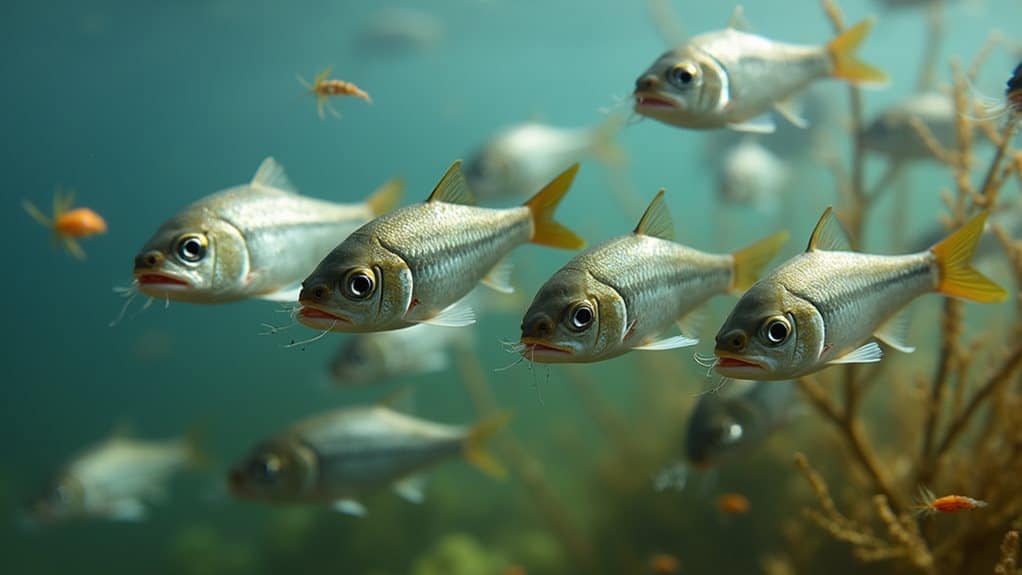
While fathead minnows might appear to be simple fish, their natural diet reveals a sophisticated feeding strategy that’s perfectly adapted to freshwater environments.
You’ll find they’re omnivorous benthic filter feeders, consuming benthic algae, protozoans, plankton, diatoms, and organic detritus. They also feed on small crustaceans and insect larvae as part of their varied diet. Kayaking with kids can provide a unique opportunity to observe these fish in their natural habitats, enhancing the outdoor exploration experience for families.
Their flexible diet allows them to thrive in diverse habitats by exploiting whatever food sources become accessible.
Animal-Based Food Sources and Prey Selection
When you observe fathead minnows in their natural habitat, you’ll notice they actively hunt various aquatic insect prey that forms the foundation of their carnivorous feeding behavior.
These opportunistic fish target insect larvae found in freshwater sediments, along with small crustaceans like copepods and amphipods that provide essential proteins for growth and development. They show clear prey selectivity when foraging, demonstrating preference for zooplankton over other available food sources in their aquatic environment. Additionally, their feeding behavior can be influenced by the sonar technologies available to anglers, which help locate fish more effectively in various water conditions.
Understanding their zooplankton feeding strategies reveals how these adaptable minnows use size-selective feeding techniques to exploit different prey sizes while minimizing competition with other fish species in their ecosystem.
Aquatic Insect Prey
As benthic filter feeders, fathead minnows actively sift through sediment layers to locate aquatic insect larvae, which form a vital protein-rich component of their carnivorous diet.
You’ll find them consuming both adult and larval aquatic insects opportunistically from freshwater sediments.
This insect prey supplements their algae-based diet, providing essential nutrients for growth, reproduction, and survival.
Zooplankton Feeding Strategies
Beyond their consumption of aquatic insects, fathead minnows demonstrate sophisticated zooplankton feeding strategies that make them highly effective predators in freshwater ecosystems.
You’ll find they’re benthic filter feeders, sifting through sediments to capture copepods, cladocerans, and ostracods.
Their size-selective feeding allows them to target different zooplankton species than competitors, reducing interspecific competition while maximizing their feeding efficiency.
Plant Matter and Algae Consumption Patterns
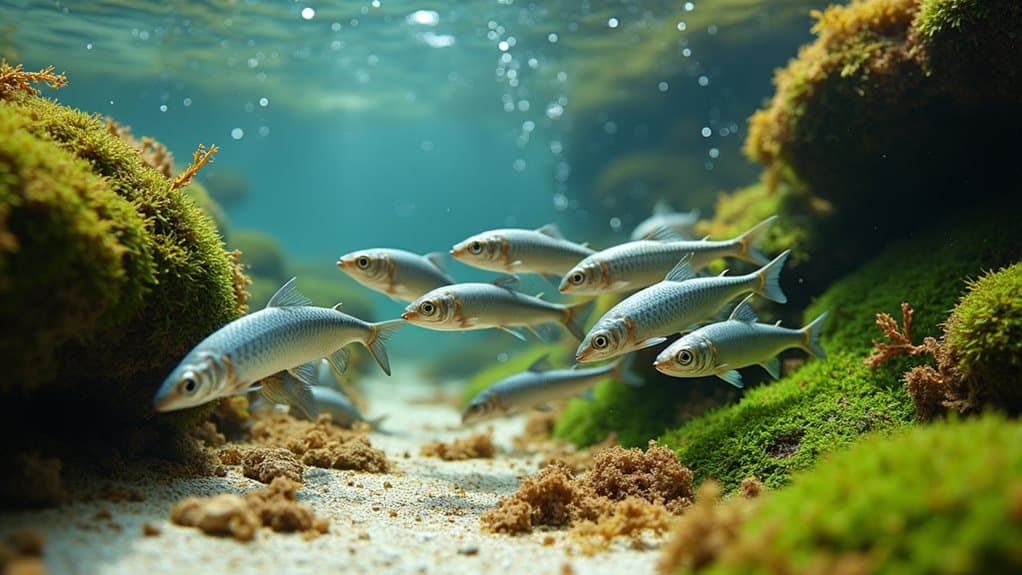
You’ll uncover that fathead minnows demonstrate distinct preferences when consuming plant matter, with their diet varying considerably based on seasonal availability and environmental conditions.
These adaptable fish primarily target specific algae types, including benthic varieties found on pond bottoms and microscopic diatoms that coat submerged surfaces throughout their habitat.
Understanding their seasonal plant feeding patterns becomes essential for pond management, as these minnows shift their consumption habits based on temperature changes and the natural growth cycles of aquatic vegetation. Moreover, studying their diet can reveal insights into cardiovascular health in aquatic ecosystems, as the balance of plant life impacts overall habitat wellness.
Algae Types Consumed
When you’re studying fathead minnows in their natural habitat, you’ll notice they primarily target benthic algae that grow on submerged surfaces like rocks, logs, and plant stems throughout freshwater environments.
They’ll consume diatoms with silica shells, filamentous algae forming thread-like structures, and various algae-coated detritus, selecting softer forms over tougher macroalgae for easier digestion.
Seasonal Plant Feeding
As water temperatures rise and daylight hours extend throughout spring and summer, fathead minnows dramatically shift their feeding patterns to consume considerably more plant matter and algae.
You’ll notice they actively sift through sediments, targeting filamentous algae and detritus when primary production peaks.
This increased plant consumption aligns perfectly with their spawning season, providing essential nutrients for reproduction and fry development.
Zooplankton and Microscopic Organisms in Their Diet
Microscopic organisms form the foundation of the fathead minnow’s diverse diet, with zooplankton serving as particularly important prey items that bridge the gap between plant and animal consumption. You’ll find these fish using pump filtering mechanisms, opening their mouths to suck in water containing phytoplankton and zooplankton, while gill rakers efficiently trap these microscopic particles. Additionally, fathead minnows are often a key part of the kayak fishing essentials for anglers looking to enhance their bait options.
Bottom-Feeding Behavior and Detritus Consumption
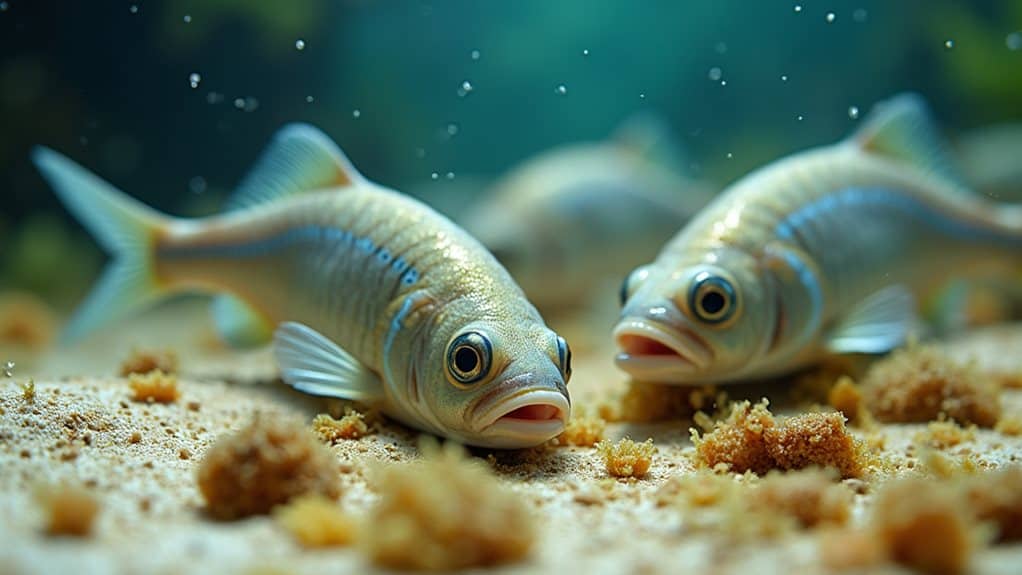
While fathead minnows are well-known for their water column feeding, they’re equally proficient as bottom-feeders, using their specialized anatomy to sift through sediments in search of nutrient-rich detritus and microscopic organisms.
You’ll find them filtering mud and silt for decomposing organic matter, algae, protozoans, and small invertebrates that inhabit benthic zones.
Seasonal Feeding Variations and Adaptability
You’ll notice that fathead minnows dramatically adjust their feeding patterns throughout the year, with their dietary needs shifting based on seasonal temperature changes and reproductive cycles.
During winter months, these adaptable fish reduce their metabolic activity and feeding intensity as colder water temperatures slow their biological processes.
However, when breeding season arrives from late spring through summer, you can observe a complete alteration in their nutritional behavior as both males and females increase their food intake to meet the demanding energy requirements of spawning activities.
Winter Diet Adjustments
As water temperatures drop below 40°F during winter months, fathead minnows undergo significant physiological changes that directly impact their feeding behavior and dietary preferences.
You’ll notice their metabolism slows dramatically, reducing feeding frequency and digestion rates.
They shift from consuming live prey like zooplankton to relying heavily on benthic detritus, organic matter, and sediment-associated organisms found in muddy substrates.
Breeding Season Nutrition
Breeding season brings dramatic changes to fathead minnow feeding behavior, with spawning activity from May through September creating intense nutritional demands that exceed their winter requirements.
You’ll notice they shift to opportunistic omnivory, targeting benthic algae, protozoans, and diatoms.
Males need substantial energy reserves for nest building and egg guarding, while females require extra nutrition for producing thousands of eggs.
Feeding Competition With Other Fish Species
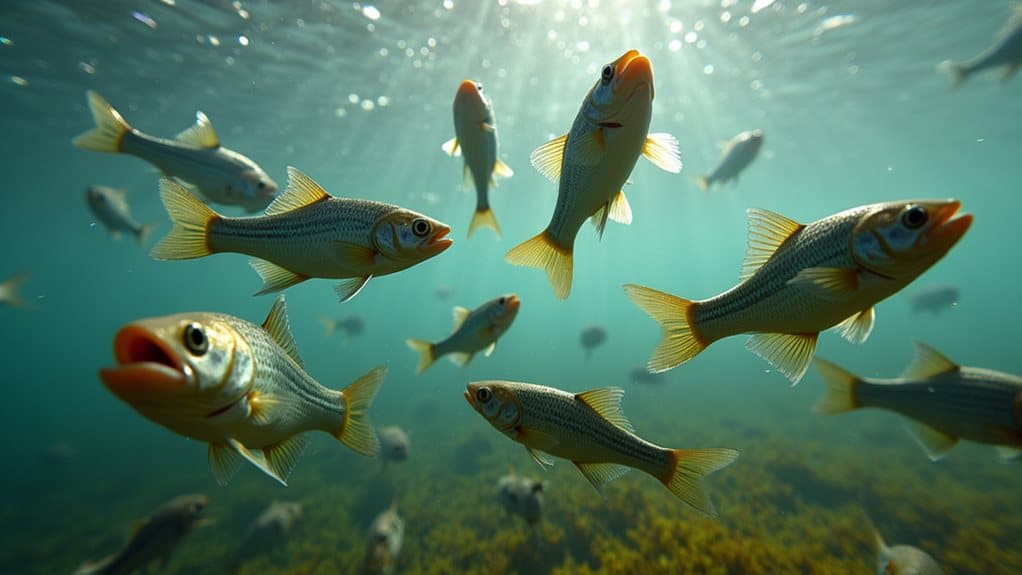
When fathead minnows share aquatic environments with other fish species, they often find themselves competing for many of the same food resources.
You’ll notice they compete with juvenile fish and forage species for algae, phytoplankton, and zooplankton.
This competition intensifies during spawning seasons and in nutrient-limited waters, potentially slowing growth rates and delaying sexual maturity in your minnows.
Nutritional Requirements During Breeding Season
Reproduction places significant metabolic demands on fathead minnows, requiring careful attention to their nutritional needs during this critical period.
You’ll need to provide diets containing 28-32% protein from commercial catfish feeds, feeding them daily to satiation.
Supplement with live foods like brine shrimp and bloodworms, which enhance spawning success by providing essential fatty acids and micronutrients.
Captive Diet and Aquarium Feeding Guidelines
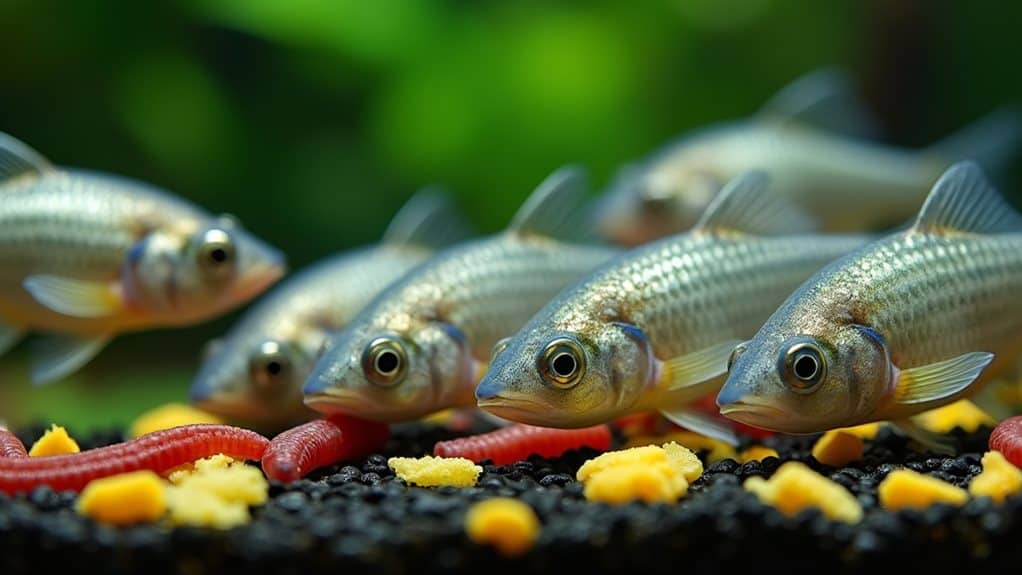
Once you’ve shifted your fathead minnows from their breeding diet, establishing proper feeding routines becomes essential for maintaining healthy captive populations.
Feed your minnows 2-3 times daily during weekdays, reducing to once daily on weekends.
Only provide what they’ll consume within 45 minutes, removing uneaten food every 2-3 days to prevent water quality issues.
Ecological Role as Both Predator and Prey
Within freshwater ecosystems, fathead minnows occupy a significant middle position in the food web, functioning simultaneously as effective predators of smaller organisms and necessary prey for larger fish species.
They’ll consume algae, protozoans, diatoms, and zooplankton while serving as fundamental food sources for northern pike, yellow perch, largemouth bass, and walleye, facilitating important energy transfer throughout aquatic communities.
Habitat Influence on Food Availability and Choice
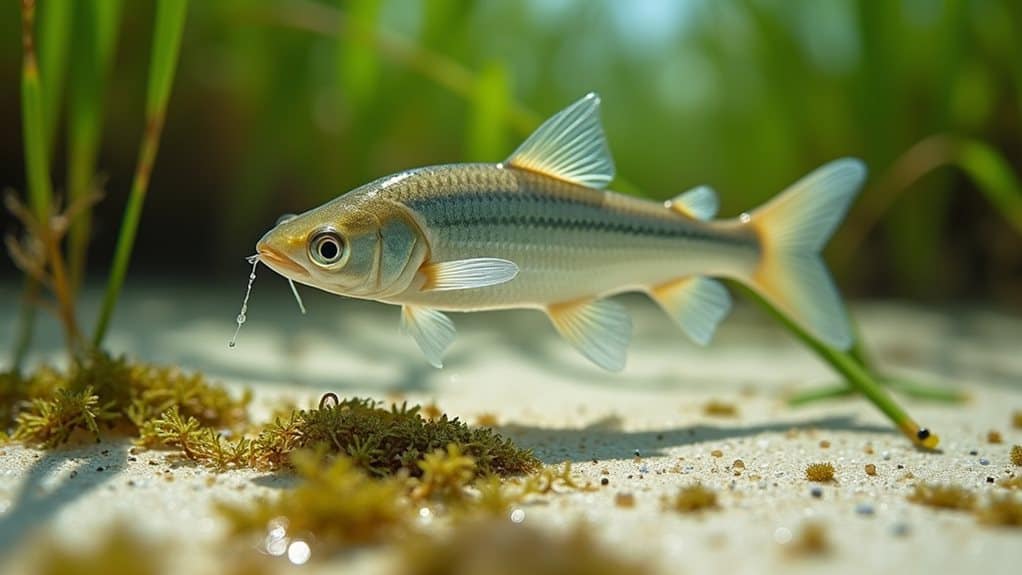
The diverse aquatic environments where fathead minnows immerse directly shape what they eat and how they find their food.
In vegetated shallow waters, you’ll find them feeding heavily on algae and filamentous algae, while sediment-rich habitats provide abundant protozoans and detritus.
Water conditions like temperature, oxygen levels, and turbidity influence their prey availability and feeding behavior considerably.
Impact of Water Quality on Feeding Behavior
While fathead minnows demonstrate impressive adaptability to various aquatic conditions, water quality greatly influences their feeding patterns and nutritional success.
You’ll find that pH levels below 6.5 reduce egg production and aquatic insect populations, limiting food availability.
Additionally, contaminants like lead and PFOS disrupt feeding behavior by damaging gill function and creating metabolic stress.
Final Note
You’ll find that fathead minnows are remarkably adaptable feeders, consuming everything from zooplankton and algae to detritus and small invertebrates. Their opportunistic nature makes them excellent for aquariums, where they’ll thrive on commercial flakes, live foods, and vegetation. Whether you’re maintaining them as feeder fish or studying their ecological impact, understanding their diverse dietary needs guarantees you’ll provide proper nutrition while appreciating their important role in aquatic ecosystems.




